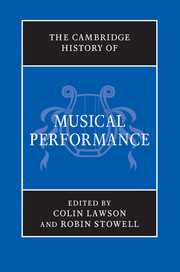Book contents
- Frontmatter
- PART I PERFORMANCE THROUGH HISTORY
- PART II PRE-RENAISSANCE PERFORMANCE
- PART III PERFORMANCE IN THE RENAISSANCE (C. 1430–1600)
- PART IV PERFORMANCE IN THE SEVENTEENTH CENTURY
- PART V PERFORMANCE IN THE ‘LONG EIGHTEENTH CENTURY’
- 20 Performance in the ‘long eighteenth century’: an overview
- 21 Vocal performance in the ‘long eighteenth century’
- 22 Instrumental performance in the ‘long eighteenth century’
- 23 Case study: Mozart, Symphonies in E flat major K543, G minor K550 and C major K551
- PART VI PERFORMANCE IN THE NINETEENTH CENTURY
- PART VII THE TWENTIETH CENTURY AND BEYOND
- PART VIII
- Index
22 - Instrumental performance in the ‘long eighteenth century’
from PART V - PERFORMANCE IN THE ‘LONG EIGHTEENTH CENTURY’
Published online by Cambridge University Press: 28 March 2012
- Frontmatter
- PART I PERFORMANCE THROUGH HISTORY
- PART II PRE-RENAISSANCE PERFORMANCE
- PART III PERFORMANCE IN THE RENAISSANCE (C. 1430–1600)
- PART IV PERFORMANCE IN THE SEVENTEENTH CENTURY
- PART V PERFORMANCE IN THE ‘LONG EIGHTEENTH CENTURY’
- 20 Performance in the ‘long eighteenth century’: an overview
- 21 Vocal performance in the ‘long eighteenth century’
- 22 Instrumental performance in the ‘long eighteenth century’
- 23 Case study: Mozart, Symphonies in E flat major K543, G minor K550 and C major K551
- PART VI PERFORMANCE IN THE NINETEENTH CENTURY
- PART VII THE TWENTIETH CENTURY AND BEYOND
- PART VIII
- Index
Summary
Arcangelo Corelli dated the dedication to his Opus 5 violin sonatas 1 January 1700, suggesting an awareness that the new century might usher in a change of outlook. By 1710, these sonatas had appeared in numerous editions across Europe and were being imitated by a multitude of composers in Italy, France, England and Germany. In a sense, they establish an agenda for the genre. The Calcinotto engraving of Giuseppe Tartini (dating, it seems, from the early 1760s) has a border with violin, bow and open music clearly marked ‘Corelli’ (plus, interestingly, volumes with ‘Zarlino’ and ‘Plato’ on their spines). In the last decade of the eighteenth century at least fifteen editions of Corelli's Op. 5 were published in Italy, Spain, France and England. Muzio Clementi produced an edition in 1800 while J.-B. Cartier brought out what he described as the ‘15th edition’ with a preface suggesting continuity between the school that Corelli established and ‘the famous artists of our times’. The sonatas of Opus 5 were to provide formative study material for generations of violinists. A case could thus be made for treating the (actual) eighteenth century (1 January 1700 to 31 December 1799) as a coherent style period.
These sonatas were, however, mid-career productions for a composer whose Op. 1 appeared in 1681. The ‘long eighteenth century’ is a useful category precisely because it accommodates changes initiated more or less anywhere in the last few decades of the seventeenth century and replaced somewhere in the early nineteenth century. Corelli as a dominant influence on violinists fits well into such a period view. From the point of view of instrumental performance there are other equally useful bookends. (The bookend metaphor seems apt, given the essential adjustability of these very practical devices.)
- Type
- Chapter
- Information
- The Cambridge History of Musical Performance , pp. 527 - 551Publisher: Cambridge University PressPrint publication year: 2012
- 1
- Cited by

